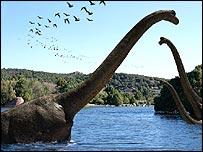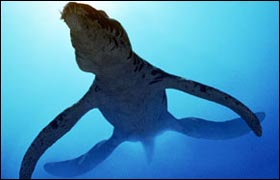A complete (but fossilized) skeleton of a giant sea creature - possibly the largest marine reptile that ever lived underground - was discovered in northeastern Mexico. The researchers identified it as the largest predator that "ruled" the depths of the ocean about 150 million years ago * The hollow spinal bones of the sauropods may have helped them float in the water of shallow lakes or rivers
The hollow spinal bones of the sauropods may have helped them float in the water of shallow lakes or rivers * according to a computer simulation that started as a joke
Brachiosaurus may have spent part of their lives in water
l

Dr. Donald Henderson from the University of Calgary in Canada developed a computer simulation to investigate what might happen if a sauropod entered deep water - would it sink or float. "We used a model on crocodiles, to see what they would do. I decided to place the sauropod data as a joke, and to my surprise it actually floated," said Dr. Henderson.
floatation problems
Dr. Henderson tried the simulation on the four known sauropod dinosaurs: Apatosaurus, Brachiosaurus, Camarasaurus and Diplodocus. All four species achieved buoyancy in the virtual water.
"They were all seen alive near water sources, but they were in trouble if the water was too deep," he told the BBC.
"If the sauropods were floating freely in a river or on the bottom of a lake, they would almost certainly have tipped on their side," Henderson says, "although their necks might have saved them from overturning completely."
When the first sauropod fossils were discovered in the 19th century, most paleontologists believed that they were marine creatures due to their enormous size. The theory was cracked in the late 40s when an American researcher proposed that if the sauropods had dived several meters underwater, the pressure would have collapsed their lungs and airways and caused their death. This view depended on sauropods having a very dense body that could have caused them to sink to the bottom. However, it was found that many sauropods had hollow vertebrae, which may have allowed them to float in water.
Whether they were stable in water or barely floated is a hypothetical question, says Prof. Martin Lockley, a geologist at the University of Colorado in Denver. "It seems to me that sauropods liked dry places and didn't spend much time in water. We find their tracks along coastlines so they had to go to lakes to drink. However, we also found them as fossils in the depths of the land, such as in the Morrison Formation, which millions of years ago was a semi-desert area, without much water," said Prof. Lockley. Paleontologists have found numerous handprints of sauropods that pushed themselves along the bottom of a lake or river with only their front legs.
Dr. Henderson says that it is likely that Brachiosaurus may have used their long front legs to drag themselves along the bottom of a lake or river.
The predator that ruled the depths of the seas
12/1/2003

A complete (but fossilized) skeleton of a giant sea creature - possibly the largest marine reptile that ever lived underground - was discovered in northeastern Mexico. The researchers identified it as the largest predator that "ruled" the depths of the ocean about 150 million years ago.
The zoological name given to it is "Leopleurodon Prox" - a type of dinosaur ("plesiosaur"). He was a meat eater and his "meals" were based on small reptiles, capable of swimming. It is estimated that the body length of this monstrous creature - from the nose to the tip of the tail - reached 25 meters and weighed over 150 tons.
At this point, the researchers gave it the name "The Monster from Arambury", after the site where it was discovered. This is the first time that a perfect fossil of such a creature has been discovered (previously only parts of the skeleton were discovered).
The experts of the Museum of Natural History in Karlsruhe, Germany, will now deal with the reconstruction of the bones, with the aim of trying and building on the basis of the skeleton, a complete figure of this animal, for display.
As far as is known, the creatures called "plesiosaurs" appeared in the world in the early Jurassic period, and quite quickly this group split into two: the long-necked ones, like the cryptocleidoids, and the short-necked ones, the "plesiosaurs".
Marine reptiles are cousins of the light dinosaurs that inhabited the earth between 208 million and 65 million years before our time.

One response
What information!!! everything is perfect! I just have a request... add more pictures to illustrate...